Ottawa, ON - From November 27 to December 1, 2006, Elmdale
Public School will be play host to an exciting demonstration of Art
in Action. Renowned Canadian landscape painter David W. Jones will be
this elementary school's 'Artist in Residence' for the week, during
which he will commence and complete a painting of an autumn landscape.
He'll also undergo close scrutiny in the process, with Elmdale's nearly
500 students paying daily visits to his easel to track the painting's
process. David will be wielding his brushes in the school's front hall
so students will have lots of opportunities to observe and interact
with him throughout the various stages of bringing a painting to life.
David W. Jones is not only an accomplished artist whose paintings hang
in prestigious galleries and public buildings across the country; he
is also the Arts Representative on Elmdale's School Council. As a member
of the NAC-sponsored Parents for the Arts Network, David is committed
to the goal of enhancing the place of the Arts in schools and building
community support for and awareness of the value of Arts in education.
For many years, staff and parents at Elmdale School have shared a common
objective of providing materials and experiences which supplement and
enhance children's education. Once again this year, Elmdale is focusing
on the enrichment opportunities afforded through the Arts - including
music, drama, dance and Visual Arts. While budgetary pressures have
impeded many schools' abilities to deliver as much fun and fundamental
Arts instruction as they used to, the Arts remain crucial to every child's
education. Why do the Arts matter? Studies have proven that children
who are exposed to the Arts not only enjoy school more, but develop
a keen appreciation for many different aspects of the world around them.
It is hoped that during David's week-long painting session at Elmdale,
students will not only learn about the process of painting, but also
about the inspiration and discipline that are fundamental to creating
Art in every form. We invite you to come to the school and see David
at work, to help highlight the importance of the Arts in education.
*** please click on any photo to enlarge
Monday, November 27, 2006
 9
a.m. David W. Jones has arrived at Elmdale Public School and set up
his easel in the main hall. He is ready to begin working on his prepared
canvas, which he has covered with his customary layer of burnt sienna
paint (a process called imprimatura). This preparation must be done
at least several weeks prior to commencing a painting, to allow the
burnt sienna to dry thoroughly. David explains that there are two
reasons for his colour choice for imprimatura: because his palette
is a similar colour, it allows for a better correspondence between
palette and canvas when he is mixing paints. In addition, the burnt
sienna colour also lends a warmth to his paintings in that it shines
through the paint applied on top of it, because of the natural translucency
of paint.
9
a.m. David W. Jones has arrived at Elmdale Public School and set up
his easel in the main hall. He is ready to begin working on his prepared
canvas, which he has covered with his customary layer of burnt sienna
paint (a process called imprimatura). This preparation must be done
at least several weeks prior to commencing a painting, to allow the
burnt sienna to dry thoroughly. David explains that there are two
reasons for his colour choice for imprimatura: because his palette
is a similar colour, it allows for a better correspondence between
palette and canvas when he is mixing paints. In addition, the burnt
sienna colour also lends a warmth to his paintings in that it shines
through the paint applied on top of it, because of the natural translucency
of paint.
 9:05
a.m. With a diluted ultramarine blue, David does a rough sketch to
place the composition onto the canvas, a process called alla prima.
This sketch serves to make sure the composition will fit nicely onto
the canvas; it will not matter that much of the detail will be lost
as he begins to apply paint.
9:05
a.m. With a diluted ultramarine blue, David does a rough sketch to
place the composition onto the canvas, a process called alla prima.
This sketch serves to make sure the composition will fit nicely onto
the canvas; it will not matter that much of the detail will be lost
as he begins to apply paint.
 9:30
a.m. Now David is blocking in areas of the painting, a process he
also refers to as 'scrubbing in'; this process is important because
it gives him greater control of the various elements in the composition.
Already his colour choices are being affected by the warmth of the
light he wants to convey in the picture. He knows he wants the sky
to be blue, because it will offer the greatest contrast to make the
pumpkins stand out more (blue is orange's opposite on the colour wheel),
but he is adding yellow to the blue of the sky to give it the warm
glow he wants, making it appear somewhat greenish. He notes that at
this stage anything can change because it is a foundation layer.
9:30
a.m. Now David is blocking in areas of the painting, a process he
also refers to as 'scrubbing in'; this process is important because
it gives him greater control of the various elements in the composition.
Already his colour choices are being affected by the warmth of the
light he wants to convey in the picture. He knows he wants the sky
to be blue, because it will offer the greatest contrast to make the
pumpkins stand out more (blue is orange's opposite on the colour wheel),
but he is adding yellow to the blue of the sky to give it the warm
glow he wants, making it appear somewhat greenish. He notes that at
this stage anything can change because it is a foundation layer.
 9:45
a.m. David pauses in his blocking to mix up four different hues for
the pumpkins, blending orange with white, yellow and cerulean blue.
He needs different hues to represent both lit and shadowed areas of
the pumpkins.
9:45
a.m. David pauses in his blocking to mix up four different hues for
the pumpkins, blending orange with white, yellow and cerulean blue.
He needs different hues to represent both lit and shadowed areas of
the pumpkins.
 10:30
a.m. Throughout the morning, teachers bring their students to observe
David at work. The children are excited to watch the painting slowly
develop, and full of questions, such as, "Is making this painting
hard?" David responds that, "Yes, making each painting is
hard, but that is one of the reasons I love being an artist."
Several students want to know why he became an artist, and David relates
the tale of how he loved to draw as a young boy, and was encouraged
to pursue his passion by a teacher. Simon, a Grade 1 student, asked,
"When you were little, did you start off with paint by numbers?"
The answer was yes.
10:30
a.m. Throughout the morning, teachers bring their students to observe
David at work. The children are excited to watch the painting slowly
develop, and full of questions, such as, "Is making this painting
hard?" David responds that, "Yes, making each painting is
hard, but that is one of the reasons I love being an artist."
Several students want to know why he became an artist, and David relates
the tale of how he loved to draw as a young boy, and was encouraged
to pursue his passion by a teacher. Simon, a Grade 1 student, asked,
"When you were little, did you start off with paint by numbers?"
The answer was yes.
 11
:15 a.m. David has inserted rough, dark shapes to represent the pumpkins
in his painting. He is now adding some blue in the area around the
pumpkins. The painting appears tonally dark and cool in temperature
(and some students mistake it for water). David explains that most
artists who work in an opaque medium prefer to progress from dark
to light. As he continues to work on the piece, he says he'll have
fun bringing light into the painting; this will cause it to change
quite dramatically.
11
:15 a.m. David has inserted rough, dark shapes to represent the pumpkins
in his painting. He is now adding some blue in the area around the
pumpkins. The painting appears tonally dark and cool in temperature
(and some students mistake it for water). David explains that most
artists who work in an opaque medium prefer to progress from dark
to light. As he continues to work on the piece, he says he'll have
fun bringing light into the painting; this will cause it to change
quite dramatically.
A student walking by stops to ask, "How many greens do you use?"
David responds that he starts with two greens, but them mixes many,
many others as he needs them, so the number of greens is practically
infinite.
 1:30
p.m. Now almost the entire painting has been blocked in. David applies
paint to all the outer edges of the canvas, then stops to closely
scrutinize his work thus far. He is assessing the painting both for
composition and the way things are placed spatially, debating with
himself about moving the trees on the left hand side further into
the background. He decides to achieve this by lightening them; he
works some of the sky colour into the trees, thereby creating a veil
of atmosphere between the viewer and the forest.
1:30
p.m. Now almost the entire painting has been blocked in. David applies
paint to all the outer edges of the canvas, then stops to closely
scrutinize his work thus far. He is assessing the painting both for
composition and the way things are placed spatially, debating with
himself about moving the trees on the left hand side further into
the background. He decides to achieve this by lightening them; he
works some of the sky colour into the trees, thereby creating a veil
of atmosphere between the viewer and the forest.
He'll now move into the fourth phase of the painting (first was the
thumbnail sketch on paper, second was the alla prima or rough sketch
on the canvas, third was the blocking in). In this phase, he will
be much more deliberate about the mixing and placement of colours,
and will work with a greater variety of brushes than just the two
larger ones he's been using up until now.
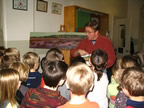 2:00
p.m. Another group of students stops by to check out the painting
and ask questions of David. He explains to them that while he does
have a photograph of the scene he is rendering perched on his easel,
from the perspectives of composition and colour he is not trying to
exactly replicate the photograph - he is just using it as a reference.
"I can vividly recall the mood, atmosphere and temperature when
I took the photo - that is important to me because I typically paint
en plein air - outdoors in the very landscapes I depict," says
David.
2:00
p.m. Another group of students stops by to check out the painting
and ask questions of David. He explains to them that while he does
have a photograph of the scene he is rendering perched on his easel,
from the perspectives of composition and colour he is not trying to
exactly replicate the photograph - he is just using it as a reference.
"I can vividly recall the mood, atmosphere and temperature when
I took the photo - that is important to me because I typically paint
en plein air - outdoors in the very landscapes I depict," says
David.
 2:30
p.m. Preparing to start work on adding more autumnal tones to the
trees, David takes a step back to look at the rhythm of the painting.
"I want to make it flow from left to right and back again; I
also want there to be a sense of movement to draw people into the
painting," he explains.
2:30
p.m. Preparing to start work on adding more autumnal tones to the
trees, David takes a step back to look at the rhythm of the painting.
"I want to make it flow from left to right and back again; I
also want there to be a sense of movement to draw people into the
painting," he explains.
Some students return for their second or third visit of the day and
are amazed at how much the painting has evolved. One student asks
why David seems to favour "long, skinny paintings". He tells
them that he believes canvases of this shape are an ideal way to represent
Canada's vast, panoramic landscape.
Tuesday, November 28, 2006
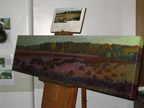 9
:10 a.m. After storing his painting and palette overnight in a cold
place to slow down the drying process, David is getting ready to go
back at work. He likes cold storage because he prefers to work in
a technique called "wet on wet" which means that he likes
to apply paint on top of wet paint. David enjoys this technique because
not only does it make it easier to blend and mix colours, he also
feels it contributes a great deal to the subtlety of the colours.
9
:10 a.m. After storing his painting and palette overnight in a cold
place to slow down the drying process, David is getting ready to go
back at work. He likes cold storage because he prefers to work in
a technique called "wet on wet" which means that he likes
to apply paint on top of wet paint. David enjoys this technique because
not only does it make it easier to blend and mix colours, he also
feels it contributes a great deal to the subtlety of the colours.
Although he also works in watercolour, for this painting, David is
using oils. He creates his medium by blending the oil paint with equal
parts of paint thinner, linseed oil and Damar varnish. These elements
help to smooth and extend the colour, as well as giving the painting
added lustre.
 9:45
a.m. David has been working on the negative space at the top of the
painting. He is defining the contours of the trees by painting in
the sky at the tops of the trees, rather than painting the trees into
the sky, which adds wonderful dimension to the painting. Further negative
space will be interspersed among the trees to give a lacelike effect
with the light shining through the forest in places. The process at
this point is slower and more meticulous than much of yesterday's
work.
9:45
a.m. David has been working on the negative space at the top of the
painting. He is defining the contours of the trees by painting in
the sky at the tops of the trees, rather than painting the trees into
the sky, which adds wonderful dimension to the painting. Further negative
space will be interspersed among the trees to give a lacelike effect
with the light shining through the forest in places. The process at
this point is slower and more meticulous than much of yesterday's
work.
 10:30
a.m. David talks to school board trustee Jennifer McKenzie who has
stopped by to see his work. He explains to her that the purpose of
spending the week at Elmdale is to expose children to art in a direct
and meaningful way, in the hopes that this will foster a lifelong
love of and appreciation for the arts.
10:30
a.m. David talks to school board trustee Jennifer McKenzie who has
stopped by to see his work. He explains to her that the purpose of
spending the week at Elmdale is to expose children to art in a direct
and meaningful way, in the hopes that this will foster a lifelong
love of and appreciation for the arts.
 11:00
a.m. Senior Kindergarten teacher Mme. Nicole Martin brings her class
down the hall to observe David in action. She shows her students a
copy of the photo and sketch that David is using as references for
this work, explaining that they too will be creating their own masterpieces.
She carefully points out that their drawings do not have to look exactly
like David's; they will be their own interpretation of the scene.
11:00
a.m. Senior Kindergarten teacher Mme. Nicole Martin brings her class
down the hall to observe David in action. She shows her students a
copy of the photo and sketch that David is using as references for
this work, explaining that they too will be creating their own masterpieces.
She carefully points out that their drawings do not have to look exactly
like David's; they will be their own interpretation of the scene.
Several children want to know when they will be able to see the pumpkins,
which are presently represented by dark shapes. David decides that
holding off on adding colour to the pumpkins will be fun, as it will
have more impact on the students when he finally does it.
One student asks, "Is it finished yet?" David replies that,
"No, this is only the second day. I have three and a half more
days to go," to which the students responds, "but it's already
beautiful." His classmate wonders, "How are you going to
get more paint on there when you've used up all the space already?"
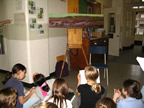 1:00
p.m. Mr. Browne's Grade 6 class comes to sketch in front of David's
easel. They have been learning about perspective in their study of
art and are trying to put this information to work. They carefully
sketch their interpretations of the painting, with some students including
the easel and other elements in the school's hallway. They'll return
tomorrow to show their sketches to David, and continue their drawings
by adding the artist at his easel to their pictures.
1:00
p.m. Mr. Browne's Grade 6 class comes to sketch in front of David's
easel. They have been learning about perspective in their study of
art and are trying to put this information to work. They carefully
sketch their interpretations of the painting, with some students including
the easel and other elements in the school's hallway. They'll return
tomorrow to show their sketches to David, and continue their drawings
by adding the artist at his easel to their pictures.
 1:30
p.m. David's palette is a very busy space as he continues to carefully
mix the exact hues he wants for each element of the painting. As he
mixes, he picks up bits of the colour with his palette knife and holds
them up near various areas on the canvas to see if he's created the
colour he is looking for, and to see how that hue will look in relation
to other tones on the canvas.
1:30
p.m. David's palette is a very busy space as he continues to carefully
mix the exact hues he wants for each element of the painting. As he
mixes, he picks up bits of the colour with his palette knife and holds
them up near various areas on the canvas to see if he's created the
colour he is looking for, and to see how that hue will look in relation
to other tones on the canvas.
 2:00
p.m. David has intensified the pumpkin's shadows and started adding
additional, lighter hues to the field area in the centre of the painting.
He is finding his progress is a little slow this afternoon because
so many classes are coming to visit, and he enjoys conversing with
all of them.
2:00
p.m. David has intensified the pumpkin's shadows and started adding
additional, lighter hues to the field area in the centre of the painting.
He is finding his progress is a little slow this afternoon because
so many classes are coming to visit, and he enjoys conversing with
all of them.
 3:00
p.m. David is now defining branches in the foreground by painting
between them, similar to the technique used to define the forest in
the background. "This contributes to the sense of depth,"
he explains. "As I suggest detail in the foreground by painting
the negative space of the field, the front of the painting moves forward,
becoming a barrier which the viewer steps over to enter the painting."
He'll work just a little while longer before putting the painting
back in cold storage for the night.
3:00
p.m. David is now defining branches in the foreground by painting
between them, similar to the technique used to define the forest in
the background. "This contributes to the sense of depth,"
he explains. "As I suggest detail in the foreground by painting
the negative space of the field, the front of the painting moves forward,
becoming a barrier which the viewer steps over to enter the painting."
He'll work just a little while longer before putting the painting
back in cold storage for the night.
Wednesday, November 29, 2006
 9 :10 a.m. David is starting his day at the easel by inserting warm
colour that will be a source of light throughout the painting. He
notices that when he added light to the pumpkins, it immediately changed
the whole canvas, so he had to start adding light in elsewhere. He
is working with smaller brushes at this point, and constantly stepping
back to re-assess the painting. He notes that from a time perspective,
progress is very slow right now. "I'm doing something that will
pay off in the end, but I wish I was working in bigger strokes like
yesterday," David explains.
9 :10 a.m. David is starting his day at the easel by inserting warm
colour that will be a source of light throughout the painting. He
notices that when he added light to the pumpkins, it immediately changed
the whole canvas, so he had to start adding light in elsewhere. He
is working with smaller brushes at this point, and constantly stepping
back to re-assess the painting. He notes that from a time perspective,
progress is very slow right now. "I'm doing something that will
pay off in the end, but I wish I was working in bigger strokes like
yesterday," David explains.
 10:00
a.m. Students are very pleased to see that the pumpkins are beginning
to be transformed from rough shapes. "Now it looks more like
a pumpkin patch," several of them remark.
10:00
a.m. Students are very pleased to see that the pumpkins are beginning
to be transformed from rough shapes. "Now it looks more like
a pumpkin patch," several of them remark.
David is now moving all around the painting, adding highlights in
various places. "If I only add them in one area, the context
remains unchanged in other areas. I prefer to have the whole painting
progress at the same time so that it does not become disjointed,"
he says.
 10:40
a.m. A kindergarten class wants to know more about how David mixes
paints on his palette. This sparks a conversation about light and
darkness, and an explanation about the sky area in the painting. "Are
you going to keep it greenish?" asks one boy. David explains,
"It will stay this colour because what you are really seeing
is not a green sky - it's a blue sky that's been warmed up. I added
some yellow paint to the blue paint, and that's why it is this colour."
10:40
a.m. A kindergarten class wants to know more about how David mixes
paints on his palette. This sparks a conversation about light and
darkness, and an explanation about the sky area in the painting. "Are
you going to keep it greenish?" asks one boy. David explains,
"It will stay this colour because what you are really seeing
is not a green sky - it's a blue sky that's been warmed up. I added
some yellow paint to the blue paint, and that's why it is this colour."
"Do you ever sell your paintings?" one boy wants to know.
"Yes, I am lucky enough to do this for a living. Isn't that great?"
replies David.
 11:15
a.m. David has removed the photograph upon which he is basing the
painting from its resting place at the top of his easel. He is holding
it up close to where he is working and referring to it frequently,
to make sure he is successfully using some of the pumpkins in the
foreground as anchors for the way the light is playing across the
field.
11:15
a.m. David has removed the photograph upon which he is basing the
painting from its resting place at the top of his easel. He is holding
it up close to where he is working and referring to it frequently,
to make sure he is successfully using some of the pumpkins in the
foreground as anchors for the way the light is playing across the
field.
An older student who has stopped by with her class asks, "In
composing the painting, did you add anything or take anything away
from the photograph?" "Yes," answers David, "I
decided to break up the band of trees which appears as a solid line
in the photo into three sections, then moved one forward and one backward,
to give the painting greater depth."
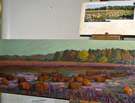 1:30
p.m. The first visitors of the afternoon remark that the painting
is becoming both lighter and brighter in tone. They also notice that
the trees have more colour and volume. Students ask about David's
use of colours; a discussion ensues about thinking of colours as temperatures.
David explains that cooler or duller colours help the background of
the painting recede, while the warmer or more intense colours becomes,
the closer the objects appear to the viewer.
1:30
p.m. The first visitors of the afternoon remark that the painting
is becoming both lighter and brighter in tone. They also notice that
the trees have more colour and volume. Students ask about David's
use of colours; a discussion ensues about thinking of colours as temperatures.
David explains that cooler or duller colours help the background of
the painting recede, while the warmer or more intense colours becomes,
the closer the objects appear to the viewer.
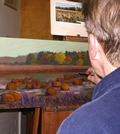 2:30
p.m. David is now applying small brush strokes of the intermediate
'pumpkin' tone to a band of dark pumpkin tone running across the middle
ground of the painting. These strokes represent the heaps of pumpkins
piled up on the field, and serve as a great lesson for visiting students
on depth and perspective. They are able to understand these sometimes
challenging concepts simply by observing how the brush strokes diminish
in size as he moves further towards the background of the painting.
2:30
p.m. David is now applying small brush strokes of the intermediate
'pumpkin' tone to a band of dark pumpkin tone running across the middle
ground of the painting. These strokes represent the heaps of pumpkins
piled up on the field, and serve as a great lesson for visiting students
on depth and perspective. They are able to understand these sometimes
challenging concepts simply by observing how the brush strokes diminish
in size as he moves further towards the background of the painting.
A teacher asks David to explain the relationship between geometry
and art. He recalls the words attributed to post-Impressionist Paul
Cezanne, who once remarked that if one can draw or paint with confidence
the four geometrics shapes with volume (sphere, cylinder, cone and
cube), then one can draw or paint anything in the world. David agrees.
 3:00
p.m. A group of kindergarten students stops by for one last look before
heading outdoors to play. They are unanimously of the opinion that
the painting is "very, very beautiful".
3:00
p.m. A group of kindergarten students stops by for one last look before
heading outdoors to play. They are unanimously of the opinion that
the painting is "very, very beautiful".
As the week is progressing, all the students' questions are becoming
more interesting and complex. This afternoon, David was asked, "Is
there any way to estimate how much paint you're going to need so you
know how much to mix up?" David responded, "I find it much
easier to mix more than I need and throw away the excess afterwards
- it is too hard to try and mix more of a certain hue later on."
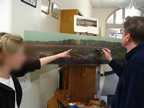 3:20
p.m. Mollie, a Grade 6 student, wants to know why David starts out
with darker colours and not light ones. "Because oil paints are
opaque, I prefer to do it in this sequence; it is one of the luxuries
of working in a medium with opacity," explains David. "This
allows you to reserve highlights till the end of the painting, which
literally brings the scene to life."
3:20
p.m. Mollie, a Grade 6 student, wants to know why David starts out
with darker colours and not light ones. "Because oil paints are
opaque, I prefer to do it in this sequence; it is one of the luxuries
of working in a medium with opacity," explains David. "This
allows you to reserve highlights till the end of the painting, which
literally brings the scene to life."
Thursday, November 30, 2006
 9:30
a.m. David has started Day 4 on this project by continuing to intensify
the colours. As the photo shows, in one area he has chosen to add
a swath of a lighter green hue to the left hand edge of the canvas,
in front of the trees. This causes the trees to appear more forward
in the painting. He is also adding brush strokes to link the band
of pumpkins to the areas in front and behind them; this helps to anchor
the pumpkins in relation to the rest of the canvas.
9:30
a.m. David has started Day 4 on this project by continuing to intensify
the colours. As the photo shows, in one area he has chosen to add
a swath of a lighter green hue to the left hand edge of the canvas,
in front of the trees. This causes the trees to appear more forward
in the painting. He is also adding brush strokes to link the band
of pumpkins to the areas in front and behind them; this helps to anchor
the pumpkins in relation to the rest of the canvas.
As he is working, he is contemplating how to approach the immediate
foreground. He eventually decides to scrub at it with a broader brush
and see how it evolves.
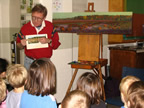 10:30
a.m. David is in constant motion, continuing to make small adjustments
all over the canvas. He is introducing new hues, including a beautiful
pale purple, so that the complexity of colour is more uniform throughout
the painting.
10:30
a.m. David is in constant motion, continuing to make small adjustments
all over the canvas. He is introducing new hues, including a beautiful
pale purple, so that the complexity of colour is more uniform throughout
the painting.
One student wants to know why there are two photos joined together,
perched at the top of the easel. David explains that he almost always
travels with his camera, and when he was at this farm to buy pumpkins
in autumn, he was struck by how beautiful the scene was. He took two
pictures side by side to better capture the panorama of the setting,
and then joined them together to make the image he would use as the
basis for this painting.
Another student wants to know why there is purple in the field, amongst
the pumpkins. David explains, "when I saw this field, it had
a lot of dirt showing. If I just painted the dirt as brown, it would
lack interest. I have chosen to represent the shadows of the clumps
of dirt in a cool, purplish hue to give the painting more texture.
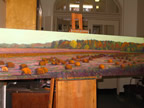 12:45 p.m. David comments that today he is hardly referring
to the photographs upon which the painting is based. Instead, he is
focusing almost exclusively on the painting itself; embellishing some
things and obliterating others. His choice of the wet on wet technique
gives him the freedom to make these changes as he wishes. "For
the benefit of a good painting, I have to be willing to take things
out, if they aren't working."
12:45 p.m. David comments that today he is hardly referring
to the photographs upon which the painting is based. Instead, he is
focusing almost exclusively on the painting itself; embellishing some
things and obliterating others. His choice of the wet on wet technique
gives him the freedom to make these changes as he wishes. "For
the benefit of a good painting, I have to be willing to take things
out, if they aren't working."
 1:15
p.m. While Grade 6 students sketch their interpretations of David
at his easel, he reminds them of the steps to make this painting,
beginning with the photographs, then onto the thumbnail sketch and
then to working on the canvas itself. He explains to them that ideally,
for a painting to develop properly, it should evolve as a whole. "You
don't want to concentrate on isolated elements without considering
other areas at the same time," he says. He also explains how
the source of light (in this case, it is coming from the right hand
side) casts itself on all the object in the painting. Thus we see
that the right hand side of the pumpkins, the leaves, etc. are all
lit, while the left hand sides are in shadow. The students remark
that their sketching activity is a difficult one, but they all seem
to approach it with enthusiasm and diligence.
1:15
p.m. While Grade 6 students sketch their interpretations of David
at his easel, he reminds them of the steps to make this painting,
beginning with the photographs, then onto the thumbnail sketch and
then to working on the canvas itself. He explains to them that ideally,
for a painting to develop properly, it should evolve as a whole. "You
don't want to concentrate on isolated elements without considering
other areas at the same time," he says. He also explains how
the source of light (in this case, it is coming from the right hand
side) casts itself on all the object in the painting. Thus we see
that the right hand side of the pumpkins, the leaves, etc. are all
lit, while the left hand sides are in shadow. The students remark
that their sketching activity is a difficult one, but they all seem
to approach it with enthusiasm and diligence.
 1:45
p.m. As David continues to make adjustments to the foreground, a group
of students speculates that the painting is going to look quite a
bit lighter when David is finished; they base this opinion on how
much lighter the painting appears today versus yesterday. David admits
that he doesn't really know himself how light it's going to end up
- he's letting the painting lead him, rather than imposing a preconceived
idea of how it should look upon completion. The students express their
confidence that the painting will be completed by end of day tomorrow.
1:45
p.m. As David continues to make adjustments to the foreground, a group
of students speculates that the painting is going to look quite a
bit lighter when David is finished; they base this opinion on how
much lighter the painting appears today versus yesterday. David admits
that he doesn't really know himself how light it's going to end up
- he's letting the painting lead him, rather than imposing a preconceived
idea of how it should look upon completion. The students express their
confidence that the painting will be completed by end of day tomorrow.
 3:30
p.m. David is putting highlights on additional pumpkins. "I am
doing this so I know how bright to make the surrounding earth; highlighting
the pumpkins changes the context yet again," he notes.
3:30
p.m. David is putting highlights on additional pumpkins. "I am
doing this so I know how bright to make the surrounding earth; highlighting
the pumpkins changes the context yet again," he notes.
Comments received to date via email include the following:
"Thank you to all of you involved in making this happen at Elmdale.
What a wonderful opportunity for our children to witness art in action.
Every night at dinner we have talked about the progress of David's
work. My girls compete to see who can give us more info. It is programs
like this one that make an education rich and full. Thank you David.
Thank-you members of the council who supported it.
- Christine, parent of two Elmdale students
"Nice to see an old media master making use of modern technology
to reach a broader audience. The Blog medium will yield a great teaching
resource for the school and pulls in a broader community. A great
idea with a nice implementation. A great complement to your wonderful
volunteer effort. Congrats."
- Shawn
Friday, December 1, 2006
9:10 a.m. David is reflective as he embarks on this, the last day
of his week as Elmdale Public School's Artist in Residence. "As
with every painting I make, my aim this week has been to create a
successful work that will sustain people's attention for a long time
- maybe forever. There should be enough complexity in a painting to
achieve this. I also hope that I've created something that allows
people to step into the scene and be touched by it."
 9:30 a.m. The first class to visit today is pleased to see more brightness
in the pumpkins, a source of much attention and interest all week.
David, in turn, is pleased to see many of the students wearing orange-coloured
clothing, just as he is. David himself urged all students to wear
orange today, for he felt that, "if we all wear orange, it will
make the pumpkins jump!"
9:30 a.m. The first class to visit today is pleased to see more brightness
in the pumpkins, a source of much attention and interest all week.
David, in turn, is pleased to see many of the students wearing orange-coloured
clothing, just as he is. David himself urged all students to wear
orange today, for he felt that, "if we all wear orange, it will
make the pumpkins jump!"
Questions today include wondering how David can stay so clean while
he paints. "When I paint, I get the paint all over myself,"
confesses one young girl. "I have been painting in oils for over
forty years," explains David. "I have had a lot of training
and developed some good work habits over time which enable me to keep
both myself and my work areas clean." Another student wants to
know why David has extended the painting onto the outer edges of the
canvas (those that are wrapped on the wooden frame). David says, "I
am not sure yet how this painting is going to be displayed or framed
so I am painting the edges in case they remain visible, even though
they might end up being covered up."
 10:15 a.m. As the painting continues to take on colour, it becomes
even more lifelike. David says that when one is painting something
that has volume, such as a pumpkin, the artist should put a bit of
reflected light on the shadowed portion of the object. This device
serves to draw the eye around the object, thereby increasing the appearance
of volume.
10:15 a.m. As the painting continues to take on colour, it becomes
even more lifelike. David says that when one is painting something
that has volume, such as a pumpkin, the artist should put a bit of
reflected light on the shadowed portion of the object. This device
serves to draw the eye around the object, thereby increasing the appearance
of volume.
Numerous parents stop by to visit David at work. Most have come to
the school today because of their children's enthusiasm in discussing
the project at home. Dawn, a mother of three young Elmdale students,
comments that her children have been very prolific in their own artistic
endeavours at home this week, likely because of David's inspiration.
"I am so glad he is doing this for Elmdale and its students,"
says Dawn.
 11:30 a.m. A favourite question posed by adults this week has been,
"how do you know when you are finished a painting?" It is
asked again this morning. David replies, "When I stand back and
see what else has to be done, and I don't see anything, then I know
a painting is complete." Ironically, the kids have been saying
for days that it looks finished to them. The concept of layering paint
has not yet occurred to many of them, especially the younger students.
11:30 a.m. A favourite question posed by adults this week has been,
"how do you know when you are finished a painting?" It is
asked again this morning. David replies, "When I stand back and
see what else has to be done, and I don't see anything, then I know
a painting is complete." Ironically, the kids have been saying
for days that it looks finished to them. The concept of layering paint
has not yet occurred to many of them, especially the younger students.
 1:15
p.m. There is a sense of dénouement as David works towards
completion of the painting. He has noticed that there is one brighter
tree in the background that he would like to diminish in attention;
when he goes to work on enhancing nearby trees he discovers that this
part of the painting is now too dry. He needs to remix some of the
area's existing colour and apply it so he can proceed with his wet-on-wet
technique.
1:15
p.m. There is a sense of dénouement as David works towards
completion of the painting. He has noticed that there is one brighter
tree in the background that he would like to diminish in attention;
when he goes to work on enhancing nearby trees he discovers that this
part of the painting is now too dry. He needs to remix some of the
area's existing colour and apply it so he can proceed with his wet-on-wet
technique.
 2:00 p.m. By this point, David has done a wonderful job of enhancing
other trees to give the background a beautiful vibrancy. He has also
added a few more highlights to the pumpkins and is now continuing
to tweak the foreground. Many students passing by comment that the
trees are their favourite part of the painting. This comes as a surprise;
we had initially expected that it would exclusively be the pumpkins
that captured their interest and attention.
2:00 p.m. By this point, David has done a wonderful job of enhancing
other trees to give the background a beautiful vibrancy. He has also
added a few more highlights to the pumpkins and is now continuing
to tweak the foreground. Many students passing by comment that the
trees are their favourite part of the painting. This comes as a surprise;
we had initially expected that it would exclusively be the pumpkins
that captured their interest and attention.
 2:55
p.m. One of last classes to visit this week sits down at David's feet.
Rather than ask questions, many of the children want to offer comments.
In addition to telling David how beautiful the painting is, they also
want to share stories about their own artistic endeavours. Several
students want to know where he gets his art supplies. Others want
to know when he will be done, and we talk about the process of understanding
when you are finished a piece of art. Visible on the wall to the left
of David's easel are the pages of this blog, printed out. Many students
and visitors to the school were intrigued to see the painting's evolution
over the course of the week depicted this way in words and pictures.
2:55
p.m. One of last classes to visit this week sits down at David's feet.
Rather than ask questions, many of the children want to offer comments.
In addition to telling David how beautiful the painting is, they also
want to share stories about their own artistic endeavours. Several
students want to know where he gets his art supplies. Others want
to know when he will be done, and we talk about the process of understanding
when you are finished a piece of art. Visible on the wall to the left
of David's easel are the pages of this blog, printed out. Many students
and visitors to the school were intrigued to see the painting's evolution
over the course of the week depicted this way in words and pictures.
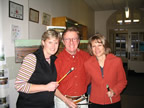 3:15 p.m. Writer Paula Roy, Artist David W. Jones and Web Designer
Debbie Holzman - this week's "Art in Action" team.
3:15 p.m. Writer Paula Roy, Artist David W. Jones and Web Designer
Debbie Holzman - this week's "Art in Action" team.
 3:41 p.m. David applies his final brush strokes. "I think that's
it," he says.
3:41 p.m. David applies his final brush strokes. "I think that's
it," he says.
David's final thoughts:
"It has been my sincere pleasure and privilege to spend this
week as Elmdale's Artist in Residence. I have enjoyed the opportunity
to have students, staff and visiting parents observe me as I created
a painting of a pumpkin patch in autumn. The children's questions
have been thought-provoking and interesting; I have been truly impressed
with their curiosity and enthusiasm for this project. We dubbed this
week a demonstration of "Art in Action" and I feel it has
achieved its goal of helping students learn in a very memorable way
how art is created. I hope that it is also achieving our other objective,
which is to foster a lifelong appreciation of and love for the Arts
in all forms. I am particularly grateful to the staff of Elmdale for
their continued efforts to make sure the Arts have a prominent place
in our children's education."
- David W. Jones, December 1, 2006


Click on painting to enlarge



